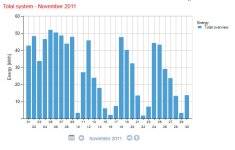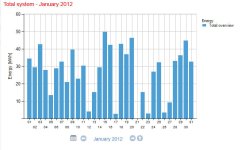The problem with you expectation of power production is likely the number of power producing hours per day. 10 hours a day is most likely the difference in your numbers and the website.
About half way down on this link is a list of US cities and the number of power producing hours available in the summer and winter,
Six Steps To Sizing A PV System
I designed a house that is passive solar, has a nice expanse of roof with a great southern exposure and with the optimum angle to the sun for solar power production. In my area, I can only expect about five hours of solar power production a day with a roof with a full southern exposure at the optimum angle.
I am lucky in that our area gets 5ish hours of useful sun time year round. Other areas have more sun time in the summer but much less in the winter or vice versa. This could also be affecting the numbers you expected vs what the online calculator showed.
Another thing to consider is that if you hot water is heated by electric power, you really should put up a solar hot water panel to heat water and not use PV power to heat the water. I figure heating water is about 20-30% of our power bill.
I am still shocked at the loss of power from the panels to the outlets. Home Power magazine mentioned a 35% loss.
6.4 KW * 5 hours of sun a day = 32 KHW per day.
32 KWH per day *30 days = 960 KWH per month.
960 KWH * .65 usable power = 624 KWH per month.
32 KWH per day * .65 = 20.8 KWH a day.
For those with PV systems, are you seeing a 35% loss of power from the rated power production on the panels?
People keep mentioning DIY installations. To qualify for the NC subsidy the system must be installed by a "professional" whatever that means. Progress Energy, our power provider, also has some programs that offer PV subsidies but the system has to be installed by the "professional. So check the rules for your location. With the exceptions of the electrical tie the install looks pretty simple to me. I could see the savings for the DIY might negate the need for the tax subsidy.
Later,
Dan

